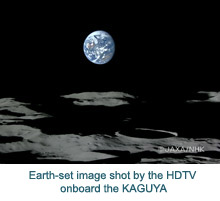 The same technology behind the ICD-809P and the ICD-879P (two new Ikegami high sensitivity cameras), available exclusively through its long-term distribution partner ADI-GARDINER, have been successfully used to take moving images from the Japanese KAGUYA (SELENE) lunar explorer.
The same technology behind the ICD-809P and the ICD-879P (two new Ikegami high sensitivity cameras), available exclusively through its long-term distribution partner ADI-GARDINER, have been successfully used to take moving images from the Japanese KAGUYA (SELENE) lunar explorer.
It is the first time that such high definition images of the earth have been shot so deep in space - about 110,000 km away from the earth. The explorer was developed by the Japan Aerospace Exploration Agency (JAXA) and launched on 14 September 2007 from the Tanegashima Space Center.
The base camera model used by SELENE (short for SELenological and ENgineering Explorer) is the HDL-40 one-piece HDTV camera, which employs 2,200,000 pixels IT CCDs and achieves excellent smear characteristics and high video quality. Using the full digital process IC (Chip-C4), 3,300,000 gate ASIC with precision designed at 0.18um rule, the video signals are fully digitized with 12-bit A/D conversion and 2x HD-SDI outputs are also available.
Weighing less than 4.0 lbs (1.8kg) and with compact dimensions W90xH130xD180 (mm), the HDL-40 provides many possibilities for various applications, such as weather cameras, overview cameras on a pan & tilt head, under- water craft, spacecraft, airborne use, surveillance and POV (Point Of View).
The special model for JAXA (based on the HDL-40) was co-developed with NHK (Japan Broadcasting Corporation) and was customised to withstand radiant (cosmic) rays, vibration, heating and cooling all found in the harsh environment of outer space.
Ikegami's president, Masaki Matsubara, said, "We are very glad to hear this successful news and Ikegami will continue supporting JAXA and NHK for the rest of the mission as well."
The ICD-809P and the ICD-879P have a true Day/Night change-over function with well-designed electronically controlled moving filter system. Both new models come equipped with an improved CCD sensor, providing amazing 540TVL horizontal resolution in colour mode and 570TVL horizontal resolution in monochrome mode under ultra low light conditions down to an amazing 0.011lux (ICD-809 series:0.015lux) minimum scene illumination performance. These cameras allow wider light spectrum coverage to the near infra-red spectrum (1000nm) to provide clear picture reproduction in very low light conditions.
















